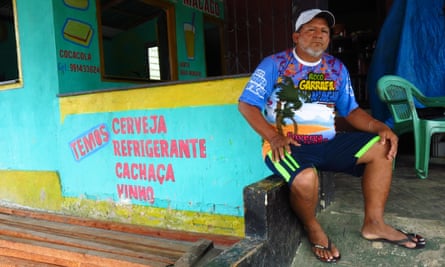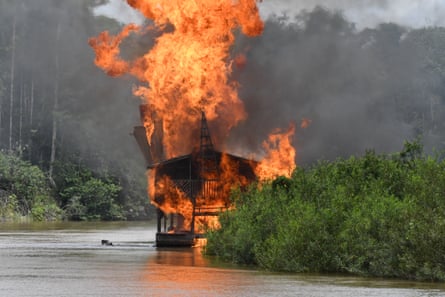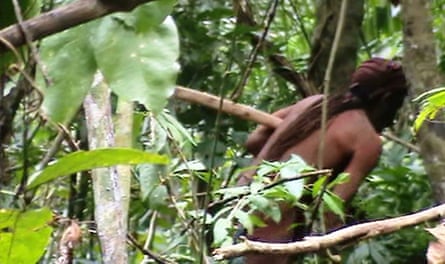A massacre of Amazon tribespeople? The search for evidence goes on
When not selling breakfasts in this sleepy town on the western reaches of the Amazon, Algenor Costa fishes and hunts along the Jandiatuba River, as he has done for decades. Heading days upriver, he has often headed into the Javari Valley, a vast indigenous reserve where such activities are forbidden.
“That’s the town larder,” he says. “Everybody enters there to fish and hunt.”
Until last year, Costa, 53, sold his catch and prey to the crews of illegal gold dredgers – known as garimpeiros– who used this town as a support base before heading deep into the reserve, sucking up gold from the Jandiatuba River and pumping poisonous mercury into its muddy waters.
Last year, however, Costa was at the centre of an inquiry into the alleged massacre of up to 10 tribespeople from an uncontacted group in the reserve. The case made headlines around the world, and forced the Brazilian government – who had already been alerted about the garimpeiros’ mining activities – into action.

In late August, a pre-planned army operation destroyed four dredgers and seized another near the town. In November, Funai staff joined a second army operation that blew up ten more mining barges and headed into the reserve to look for evidence that a massacre had occurred.
A flight over the area found burnt maloca longhouses – a common practice by local isolated tribes after a death
But they were unable to find anything conclusive. Instead, while prosecutors are still to close their investigation, the case has exposed the vulnerability of isolated groups in the Javari Valley, the prejudice indigenous people face in communities around them, and the difficulties of such investigations in areas of inaccessible wilderness.
Locals said it was the third time the garimpeiros had set up in São Paulo de Olivença. Although many were out-of-towners, some locals, including Costa, delivered supplies to them. The garimpeiros barges’ were located days by boat from the town, deep inside the reserve.
“We fish, hunt and bring what we get here. And on the way back, the garimpeiros [would buy] some things from us,” Costa says. For isolated tribes, the presence of outsiders nearby is potentially fatal, as they have no immunity from even common diseases like flu.
Costa and two other men, Manoel Castro and Roque Alves Rocha, were named in an anonymous denunciation received last August by Funai, Brazil’s indigenous agency, which included a badly recorded conversation and a photo of Costa with a paddle. The tip-off said the men had boasted of killing up to 10 indigenous people and had stolen the paddle and other artefacts. Other evidence led credibility to the denunciation. A flight over the area found some malocalonghouses had been burnt – common practice after a death in local tribes.
Prosecutors in Tabatinga – a city six hours away by boat – opened an investigation and requested arrest warrants for the three men. A judge turned these down and authorised searches of their properties instead.
Interviewed by TV Globo’s national news programme Jornal Nacional, the three men denied the accusations that they had been responsible for a massacre. “It is something I never did,” said Rocha. Castro said he had not seen the indigenous people, but that he and Costa had found two paddles in a canoe and taken one. Costa refused to say any more to the channel.
But in an interview with the Guardian, Costa refuted being on the recording and said that he and Manoel Bida had found the paddle two years earlier in a canoe at a place called Três Bocas, deep inside the reserve, near footprints an isolated group had left crossing a river.

“We didn’t see them, just their traces. It’s common there,” he says. Costa alleges that the supposed massacre had been devised by those who want to force the authorities to act over gold dredging, but doesn’t specify who this might be.
He says it would be impossible to kill so many light-footed indigenous people and survive. He also alleges, despite having no evidence, that the isolated tribe practises cannibalism.
“If they kill us, they eat us,” he says.
Indigenous people around São Paulo de Olivença routinely face discrimination, but prejudice against them has increased since the denunciation, for which they were unjustly blamed, says one local leader, talking anonymously after receiving threats.
Speaking to the Guardian, some local people say they feel indigenous people receive too much money in government benefits and believe the reserve is too big for the indigenous population that live there. Funai staff were threatened when they reached the town in November 2017 for a joint operation with army and environment agency officials, a federal prosecutor says. Three months had passed since the original tip-off – a delay criticised by Sydney Possuelo, a former Funai president who had been instrumental in gaining protected status for the Javari Valley.
As they headed upriver, soldiers blew up 10 dredgers. Funai officials quizzed crews and left the soliders working to reopen one of the agency’s bases on the Jandiatuba River, which had been closed in 2012.

This was important to deter garimpeiros from entering the area, says Beto Marubo, an indigenous leader working to raise international attention over the threats to the Javari Valley’s 16 isolated tribes.
“Without these bases, the isolated Indians who roam this territory become vulnerable,” he says.
The Funai group carried on up the Jandiatuba River. Before reaching Três Bocas, they had found an abandoned gold dredger. At the site of the alleged massacre, they found no sign of the killings – though what evidence would have remained after three months is unclear. No police took part in the expedition.
We stayed for six minutes in the village of the uncontacted tribe. It was very tense. It felt like an eternity
This was a difficult trip involving arduous travelling through remote and inhospitable terrain, says Bruno Pereira, the Funai isolated indigenous specialist who led a team that included Jair Candor, one of Funai’s most experienced isolated authorities (featured in award-winning documentary Piripkura). Since 1987, Funai has avoided contact with isolated tribes – who have attacked and killed employees in the past, and been decimated by viruses passed on by outsiders.
Trekking inland in search of signs that the tribe was healthy, they came across a plantation of fruit and vegetables, then a settlement. Because of the seriousness of the denunciation, they decided to enter and found fires still smouldering, temporary thatched-roof shelters called tapiri, slings for blowpipes, clay pots, arrowheads, bones of tapir, wild boar and alligator that had been cooked and eaten, as well as a body-length ceremonial mask.
They stayed for six minutes. “It was very tense. [It felt] like an eternity,” says Pereira.
If the alleged massacre had happened, it was unlikely that this established settlement would still be there, he says, because isolated groups flee danger. This conclusion is shared by Daniel Mayaruna, 44, an indigenous man from Javari who was also on the expedition. Daniel saw a community of his “relatives” in good shape, but says the abandoned mining barge just 10km away was profoundly worrying.
“There are a lot of isolated relatives in this region and my concern is that garimpeiros could kill them,” he says.

Adam Mol, a volunteer Polish doctor, shot video footage of the village. “We didn’t find any indications of a massacre,” he says.
Accusations of massacres are not unknown in the Javari Valley. Last August Bruno Pereira, the Funai official responsible for monitoring its isolated groups, led an expedition in the south of the reserve, following reports of another mass killing related by an indigenous man. Mol went with him.
Mol brought a drone along – equipment that Funai did not have. The agency has been decimated by budget cuts under the austerity regime of President Michel Temer.
As the expedition headed along the Jutaí River, around the area where the killing allegedly took place, they came across a small camp on the side of the water that the isolated group had just vacated, leaving an axe, bow and arrow and other artefacts behind. Then Mol’s drone spotted the main village just a kilometre away, with people, communal thatched buildings, and plantations. They retreated, reasoning that the group would have moved had they suffered a massacre.
“The drone footage gave us the intel we needed,” says Mol.

Both cases underline just how hard it is to investigate allegations of possible crimes in such remote regions.
In Tabatinga, federal prosecutor Pablo Beltrand says the tip-off over the supposed Jutaí River massacre was “not such a reliable report” and presented “contradictions”. On the alleged massacre involving the tip-off, Beltrand has just received Funai’s report on the expedition and is analysing it. The agency had been reluctant to share sensitive information, such as the location of isolated groups.
That the isolated tribe has stayed in the region is “something to be considered in the investigation”, Beltrand says. He has yet to conclude his inquiry.But he has little to go on – a paddle, a conversation, an anonymous denunciation. Meanwhile, smaller wooden mining barges are now reportedly being built beside a river in São Paulo de Olivença. The garimpeiros may yet return.
- Tribes in deep water: gold, guns and the Amazon’s last frontier
- Lost tribes: the 1000km rainforest mission to protect an Amazon village